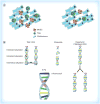Unlocking the promise of oncolytic virotherapy in glioma: combination with chemotherapy to enhance efficacy
- PMID: 25996044
- PMCID: PMC4446703
- DOI: 10.4155/tde.14.123
Unlocking the promise of oncolytic virotherapy in glioma: combination with chemotherapy to enhance efficacy
Abstract
Malignant glioma is a relentless burden to both patients and clinicians, and calls for innovation to overcome the limitations in current management. Glioma therapy using viruses has been investigated to accentuate the nature of a virus, killing a host tumor cell during its replication. As virus mediated approaches progress with promising therapeutic advantages, combination therapy with chemotherapy and oncolytic viruses has emerged as a more synergistic and possibly efficacious therapy. Here, we will review malignant glioma as well as prior experience with oncolytic viruses, chemotherapy and combination of the two, examining how the combination can be optimized in the future.
Figures

Similar articles
-
Oncolytic Viruses for Malignant Glioma: On the Verge of Success?Viruses. 2021 Jul 2;13(7):1294. doi: 10.3390/v13071294. Viruses. 2021. PMID: 34372501 Free PMC article. Review.
-
The integrin inhibitor cilengitide enhances the anti-glioma efficacy of vasculostatin-expressing oncolytic virus.Cancer Gene Ther. 2013 Aug;20(8):437-44. doi: 10.1038/cgt.2013.38. Epub 2013 Jul 5. Cancer Gene Ther. 2013. PMID: 23827879 Free PMC article.
-
[Oncolytic properties of some orthopoxviruses, adenoviruses and parvoviruses in human glioma cells].Vestn Ross Akad Med Nauk. 2013;(12):4-8. Vestn Ross Akad Med Nauk. 2013. PMID: 24741936 Russian.
-
Efficacy of systemically administered oncolytic vaccinia virotherapy for malignant gliomas is enhanced by combination therapy with rapamycin or cyclophosphamide.Clin Cancer Res. 2009 Apr 15;15(8):2777-88. doi: 10.1158/1078-0432.CCR-08-2342. Epub 2009 Apr 7. Clin Cancer Res. 2009. PMID: 19351762
-
Virus combinations and chemotherapy for the treatment of human cancers.Curr Opin Mol Ther. 2008 Aug;10(4):371-9. Curr Opin Mol Ther. 2008. PMID: 18683102 Review.
Cited by
-
Oncolytic Viruses for Malignant Glioma: On the Verge of Success?Viruses. 2021 Jul 2;13(7):1294. doi: 10.3390/v13071294. Viruses. 2021. PMID: 34372501 Free PMC article. Review.
-
Retargeted adenoviruses for radiation-guided gene delivery.Cancer Gene Ther. 2016 Sep;23(9):303-14. doi: 10.1038/cgt.2016.32. Epub 2016 Aug 5. Cancer Gene Ther. 2016. PMID: 27492853 Free PMC article.
-
Advances in Immunotherapies for Gliomas.Curr Neurol Neurosci Rep. 2022 Jan;22(1):1-10. doi: 10.1007/s11910-022-01176-9. Epub 2022 Feb 2. Curr Neurol Neurosci Rep. 2022. PMID: 35107784 Free PMC article. Review.
-
Hitting the nail on the head: combining oncolytic adenovirus-mediated virotherapy and immunomodulation for the treatment of glioma.Oncotarget. 2017 Sep 11;8(51):89391-89405. doi: 10.18632/oncotarget.20810. eCollection 2017 Oct 24. Oncotarget. 2017. PMID: 29179527 Free PMC article. Review.
-
A Comparative Study of Replication-Incompetent and -Competent Adenoviral Therapy-Mediated Immune Response in a Murine Glioma Model.Mol Ther Oncolytics. 2017 May 6;5:97-104. doi: 10.1016/j.omto.2017.05.001. eCollection 2017 Jun 16. Mol Ther Oncolytics. 2017. PMID: 28573184 Free PMC article.
References
-
- Wen PY, Kesari S. Malignant gliomas in adults. N Engl J Med. 2008;359(5):492–507. - PubMed
-
- Mcgirt MJ, Chaichana KL, Gathinji M, et al. Independent association of extent of resection with survival in patients with malignant brain astrocytoma. J Neurosurg. 2009;110(1):156–162. - PubMed
-
- Stupp R, Mason WP, Van Den Bent MJ, et al. Radiotherapy plus concomitant and adjuvant temozolomide for glioblastoma. N Engl J Med. 2005;352(10):987–996. - PubMed
-
- Kelly E, Russell SJ. History of oncolytic viruses: genesis to genetic engineering. Mol Ther. 2007;15(4):651–659. - PubMed
Publication types
MeSH terms
Substances
Grants and funding
LinkOut - more resources
Full Text Sources
Other Literature Sources
Research Materials
